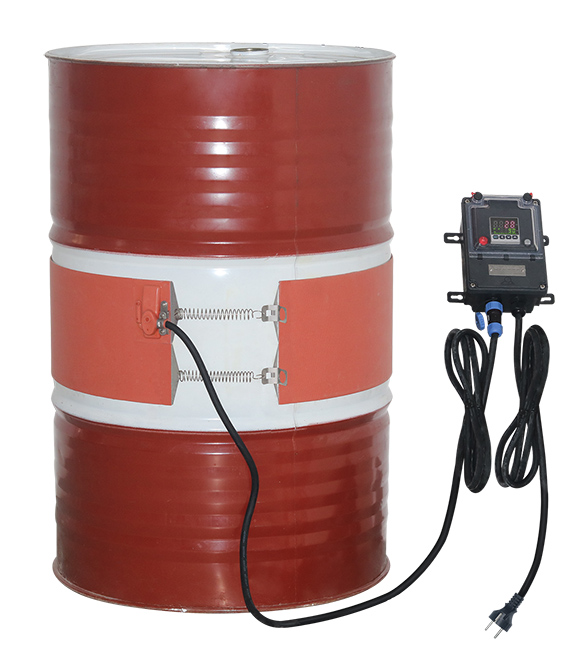

Main features
Silicone rubber belt heaters are made of fiberglass reinforced laminated silicone rubber sheets, vulcanized together through heat and high pressure on both sides of an embedded specially formed heating wire element. Fiberglass-reinforced silicone rubber gives the heater dimensional stability without sacrificing flexibility.
Silicone is used because of its high temperature resistance (Constant temperature up to 200°C (390°F), high thermal conductivity (~7 10-4 W/cm.K) and good electrical insulation properties (~12KV/mm)
This series is distinguished by the use of a remote electronic control system, on-off action, with digital display of the measured value, connection by waterproof connector for easy disconnection of the heater, and IP65 ingress protection class for the whole assembly. This allows its use in industrial applications when a precise and without overheat temperature control is requested
Other general particularities of these flexible silicone heaters are:
- Not affected by vibration or flexing,
- Lightweight,
- Comply with UL94-VO (flame retardant) and ROHS,
- Low smoke and low Toxicity,
- Silicone is non-toxic, and moisture and chemical resistant.
-Very thin profile.
Main Applications
Combining high power density with flexibility silicone heating belts are a simple and economical solution for heating metal drums.
They bring and maintain products to the consistency required for their use. Some typical applications examples are:- Consistency control of paints, oils, greases, fats, molasses, adhesives, plastics, mastics, resins, syrups,
- Freeze protection,
- Maintaining liquid temperatures at 45-65°C (115-150°F) in food industry water purification systems, - Maintain polyester resin at 20-25°C (70-80°F) for spray and pour equipment.
Technical Features
Clamping on drums: By spring and hook lock-up that allows adjusting the band to the drum diameter; change position to the right place as content levels fluctuate; and also keeps the band tight to the drum surface, providing good thermal contact. Clamping force of each spring is from 1 to 3DaN in the recommended drums diameter range. The spring is equipped with a pull ring for easy installation and removing of the belt.
Length (Dimension A): designed to be used on standard container diameters. Consult factory if a custom size is requested.
Width (dimension B): 100mm (4”), 200mm (8”) 300mm (12”), and 400mm (16”). Heating belts must always be applied on cylindrical surfaces without hoops or ribs.
Silicone foil minimum bending radius: 3.2mm (0.125”)
Ingress protection: IP65.
Minimum ambient temperature: -10o C (+15o F)
Voltage: 220-240VAC.
Power tolerance: ±10% at 20°C
Temperature control: Controller with double display, of process value and of set-point, located in an independent waterproof housing, designed for wall mounting. It is connected to the flexible silicone rubber heater by a cable equipped with a 5-pin waterproof quick connector, facilitating the connection and disconnection with the heater. It controls the temperature by means of a probe placed under a silicone boot on the outer surface of the heater. Action: PID with automatic parameters adjustment by auto-tune function.
Sensor input: Pt100
Power output: solid state relay, maximum 16A 230V.
Alarm: 3A 230V relay.
Display: 4 digits display configurable in °C or °F
Power supply: AC 220-230V 50-60Hz.
Accuracy: ±1°C (±2°F) or 0.3% ES± one digit.
Self-testing: open sensor circuit.
Ambient temperature: -10 to 60°C, 20 to 85% relative humidity, non-condensing.
Temperature display range: Configurable
Resolution: 0.1°
Read instruction manual before the setting of this temperature controller.
Power density:
- 0.75 w/cm2 (4.8 w/inch2), for usual applications.
- 1 w/cm² (6.5 w/inch2) for fast heating applications
Thickness of the flexible silicone foil: 2.5mm. (Optional 3.2mm, for heavy duty applications requiring strong mechanical strength and reinforced insulation).
Quality control routine tests: Each element is 100% tested for continuity, resistance and insulation. Tests are made according to EN 60335-1 and EN 50106 standards. See technical introduction.
Dielectric Strength: 1750V AC.
Insulation resistance: ≥ 10 Megohms.
Operating temperature:
The temperature measured by the electronic controller is that of the heating surface. The temperature of the heated product is generally much lower than that of the surface and depends mainly on the surface power (W/cm²), the quality of the thermal contact with the container, the viscosity, heat capacity and thermal conductivity of the heated product, the good positioning of the heating belt, the set point value, and room temperature (See technical introduction).
You can find in the technical introduction examples of the temperatures reached by silicone heating belts. They represent the temperature that may reach the heating belt if it is not correctly installed (for example: poor thermal contact, empty container or improperly temperature controlled).
Connection cable:
Insulated rubber power supply cable, for industrial environments, 3 x 1.5mm² length 3m, Euro plug. UL plug on request.
Options:
- Power density reduced to 0.2 W/cm² (1.3 w/inch²) for plastic containers- 3.2mm reinforced thickness.
- Power supply 110/115V
- Power cord with industrial plug 2-pole + earth 16A CEE (IEC60309)- Surface temperature limiter.
- Grounded metal mesh layer.
- Outside thermal insulation by silicone foam layer
Safety standards:
The heaters have been designed in compliance with EECLow Voltage Directive (LVD) 2006/95/EC and EMC directive 2004/108/EC. They must be installed in accordance with all local applicable instructions, codes, and regulations.

